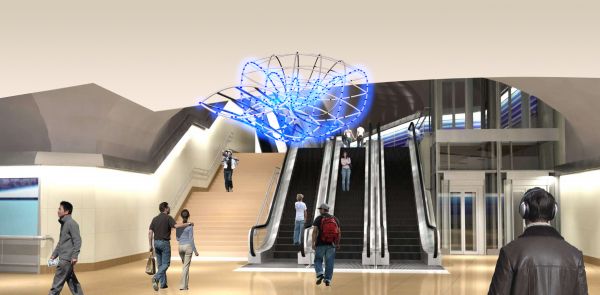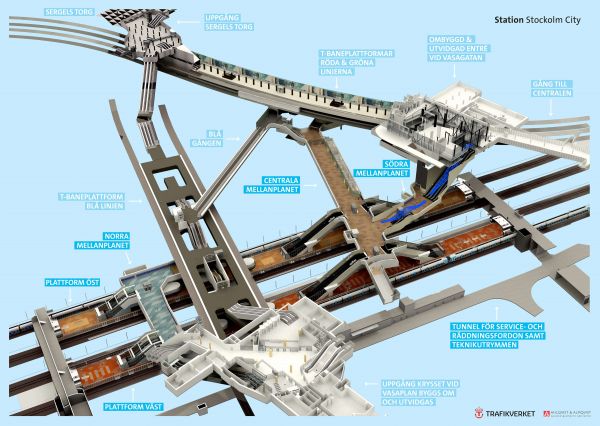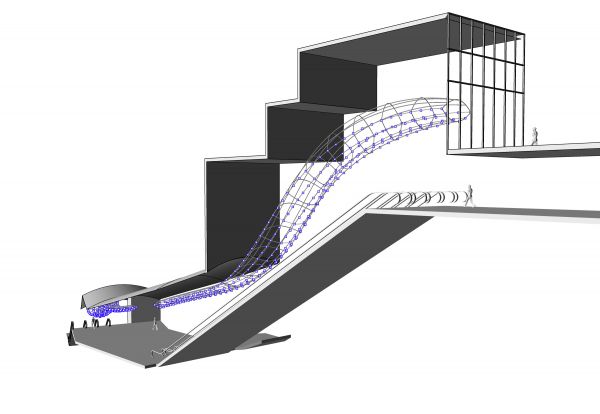Flow
2011. Stockholm City Metro, Sweden
Why is a design that is not implemented interesting nevertheless? First of all, I would say, to encourage myself and other artists to continue their participation in national and international competitions for art works.
A new assignment teaches you a lot and you interact with other artists, engineers, project management and customers. The design world is getting bigger and wider. The Dutch Minister Joseph Luns once said: “I am minister of foreign affairs of a small country but with a gigantic abroad.” Furthermore it deepens your oeuvre as you are creating solutions to challenges you never got around to tackling. To get a better grasp on design situations you continue to judge new tasks again and again on their size and depth as well as call upon inspiration and creativity which you thought before you would not have. This forms an incredible treasure. In addition, the publically announced design tenders are opportunities in which dozens or hundreds of artists wish to participate, with equally little chance. Thus… shooting five times and hitting once can be called a very favourable outcome.
From the 700 registrations to participate in an art competition for a metro station in Stockholm, Sweden, I was – to my great surprise – one of three artists selected for the last round and I was invited to fabricate, against payment of a modest remuneration, a preliminary design. Station Stockholm City promises to become an attractive metro station. The escalator leading to the ‘mellanplanet’ (where travellers have to choose their platform) is, as is very common in metro stations, rather long and deep. The often passive movement on longer and shorter escalators is followed by active passenger movements realized by walking. In the end, one arrives at the point of having to choose between platform ‘Öst’ and platform ‘Vast’ – the east- and westbound directions. An important, maybe even essential element of the architecture in this part of the station is the ‘mellanplanet’. Through the ‘biljetthallen’ (ticket-hall), it is provided with natural daylight streaming along the ceiling of the escalator. This setup ensures that people leaving the metro can gradually adapt their eyes from artificial to natural light and vice versa.
As a reference to the subterranean world and the layers of history I imagined a kind of fossil, a gigantic marine animal, abstracted to an art work. Thanks to minimal dimensioning and the completely transparent character the art work follows the natural stream of light. The fabulous pearlescent coating on the tubes provides, thanks to its shine, for a further enhancement of its reflections and creates ever changing colour shades, depending on the light circumstances. Visually the work of art joins the light on its way to the ‘mellanplanet’. By hundreds of leds the work can be an additional support to the general lighting – they twinkle in the daylight but only begin to sparkle under circumstances with little surrounding light, such as in early mornings and late afternoons or evenings and the dim light during winter times. It would also be possible to install stronger leds close to the ‘mellanplanet’ so that certain subtle light effects could be created.
The part of the art work that fills the glass space on the ground level – the ‘head’ of the work – is of a very recognizable character. It is simple and is quickly associated with the public function of a metro. The small leds in the ‘head’ of the art work take care of the sparkling in the glass space and create hundreds of reflections in the glass panels, this making it a jewel and an eye-catcher for the metro. In conclusion, the work of art is a support for the way people navigate through the station, complementary to the architecture and a striking pearl for Station Stockholm City!
For this Swedish metro with its rocky depth, the levels to which you are moving have to be crystal clear. In contrast to the Dutch ‘apple sauce ground’ the ground underneath the city of Stockholm is very rocky. Wang Xing, a brilliant man from Shanghai, who finished his master’s degree in architecture in Delft, the Netherlands, was able to translate my sketches into a digital 3-D-design. Transparency and clarity: a labyrinth of leds is curling from top to bottom, changing in shades of colours and can, once outside the metro, even be seen from above. This art work with the title Flow, made of steel and coated with a pearlescent colour, could have made many people in the metro of Stockholm happy! To get flow essentially means becoming ecstatic!






